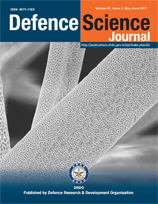Effect of Ceramic Properties and Depth-of-penetration Test Parameters on the Ballistic Performance of Armour Ceramics
DOI:
https://doi.org/10.14429/dsj.67.10664Keywords:
Armour ceramics, Ballistic performance, Mechanical property, Quantitative analysisAbstract
Through an analysis on the relationship among ceramic properties, the depth of penetration (DOP) test parameters and the ballistic performance of armour ceramics based on literatures, the effects of ceramic type, tile thickness and projectile velocity on the ballistic performance of different kinds of ceramics were investigated systematically. The results show that the ballistic performance of different armour ceramics mainly depends on its density, and by using thin ceramic tiles or under high velocity impact, the ceramic composite armour could not provide effective ballistic protection. Furthermore, the differences in the ballistic performance of armour ceramic are found due to the different ballistic performance criteria and DOP test conditions. Additionally, the slope of the depth of penetration (not include tile thickness) (Pa) versus tile thickness has negative correlation with flexural strength of ceramics, indicating the flexural strength can be one of the criteria to evaluate the performance of armour ceramics.
Downloads
Published
How to Cite
Issue
Section
License
 Where otherwise noted, the Articles on this site are licensed under Creative Commons License: CC Attribution-Noncommercial-No Derivative Works 2.5 India
Where otherwise noted, the Articles on this site are licensed under Creative Commons License: CC Attribution-Noncommercial-No Derivative Works 2.5 India


